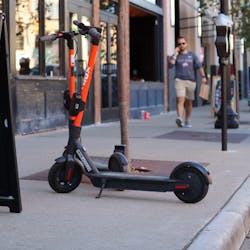Unlocking the micromobility revolution
The nascent but skyrocketing growth of micromobility (i.e., small, lightweight vehicles) is completely transforming not just transit but urban life. This environmentally-friendly concept, which represents last-mile transport, helps alleviate traffic congestion while providing a comfortable, individual transit method tailored to each rider's needs. And during the COVID-19 pandemic, usage of micromobility options, such as e-scooters and e-bikes, has been consistent because they allow for social distancing at a time when commuters are wary of traveling on buses, trains or subways.
So, is micromobility truly a silver bullet for modern transportation, a cure-all for sustainable and carefree travel? Perhaps, but the reality of the current situation is much more complicated for both residents and policymakers alike.
Dockless e-scooters are a microcosm of the current challenges. As with other forms of micromobility like e-bikes, the e-scooter industry is experiencing exponential growth. In 2018, the National Association of City Transportation Officials estimated there were more than 38.5 million e-scooter trips in the U.S. alone. In 2019, the e-scooter company Lime announced the company had reached 50 million trips since launching only two years prior.
But there have been growing pains too, as the vehicles can be inappropriately parked, making them a nuisance that blocks sidewalks, doorways, fire zones and access points for the disabled. Operators worldwide also strain to track and manage their assets, which hinders the e-scooter boom from expanding to more cities. Residents may be hesitant to embrace this new form of mobility when it presents so many issues.
These problems, combined with limited public resources, are a roadblock for administrators attempting to manage the rapid proliferation of e-scooters. Because the industry is so new, municipalities worldwide can struggle to regulate it, taking significantly different approaches to find a consistent solution.
For instance, it is legal to rent e-scooters for road use in the United Kingdom, but e-scooter owners can only ride them on private land. In Germany, private riders must purchase insurance first, which is included when riders use a rental e-scooter. In the U.S., regulations vary state-by-state, but overall, jurisdictions have generally pulled back on their embrace of e-scooters because of the above issues.
Fortunately, policymakers are making progress on several fronts. New regulations have helped bring order to the industry, enabled by better tracking technology. Data is vital to the micro-mobility revolution because, in general, human monitoring and enforcement are not sustainable long-term solutions. Automated processes for data collection and location analytics help to solve the challenges involved with e-scooters.
Case in point: Munich, Germany, has an initiative to track shared mobility vehicles, such as e-scooters, bikes and cars. The plan is to capture data from a variety of mobility providers in one IoT-capable platform, then perform spatial and other data analysis to track patterns of movement and how events and city regulations influence behavior. The initiative also supports better coordination between the city and service providers to improve curbside management. For example, during a parade, the platform would be used to define temporary time and location-based restrictions for the different classes of vehicles and automatically communicate this information to the shared mobility providers to inform their operations well in advance. Not only will Munich’s initiative pave the way to solve many of the challenges presented by e-scooters and other shared mobility vehicles, but it will also help officials better identify and understand transportation patterns and guide mobility concepts of the future based on data.
With such information, jurisdictions can target improvements. For example, in Provo, Utah, an expert panel found that posting signs in high traffic areas increased e-scooter users' knowledge about safety precautions. Other cities provide racks or poles on which commuters can lock their devices.
As shown by e-scooters, micromobility is becoming a leading option for commuters and environmentally-minded cities. These vehicles can help many metropolitan areas achieve their goals for sustainability in transportation, and hence, micromobility will thrive over the long term as regulations and technologies mature. In fact, forecasts for the number of passenger-kilometers traveled through micromobility have increased recently, in part due to the pandemic and aforementioned social distancing concerns.
Like any new industry, challenges have arisen that must be met. But, as examples like Munich show, when governments have initiatives in place for obtaining the most up-to-date and usable data and a commitment to using that information to guide strategy and policy, they can adopt micromobility transportation options more quickly and successfully.
-------------
Dr. Uwe Jasnoch is vice president of Business Development of Hexagon’s Geospatial division.


